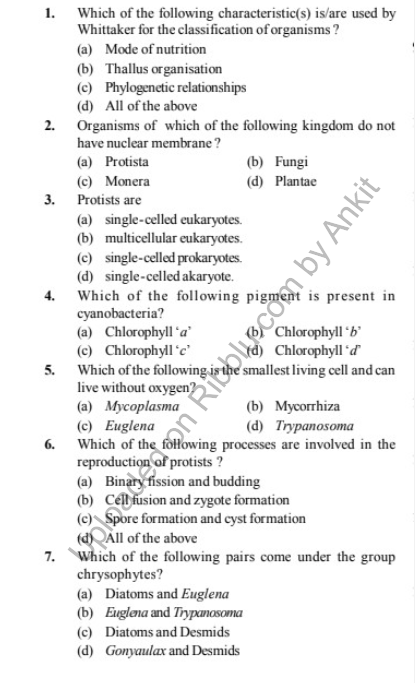Biology MCQs ( Multiple Choice Questions ) for Class 11 Chapter Wise with Answers PDF Free Download is very important for students who want to improve their grades in CBSE board examination. Solving these MCQs with answers provided here simplifies learning. Practise these Biology MCQs for Class 11 provided with answers and tabulated chapter-wise, and improve your score.
Biology MCQ Questions for Class 11 with Answers Pdf Download
Solving NCERT Online Biology MCQ Questions for Class 11 with Answers aids students to better understand concepts and recall learnt concepts while solving. There is no substitute for consistent practice whether one wants to understand a concept thoroughly or one wants to score better. By practicing more Biology MCQs with Answers, students can improve their speed and accuracy which can help them during their board exam.Here’s the list of chapters on the “Biology – Class 11” subject covering important topics. You can practice the MCQs chapter by chapter starting from the 1st chapter or you can jump to any chapter of your choice.
- MCQ Questions – Chapter 22 Chemical Coordination and Integration
- MCQ Questions – Chapter 21 Neural Control and Coordination
- MCQ Questions – Chapter 20 Locomotion and Movement
- MCQ Questions – Chapter 19 Excretory Products and their Elimination
- MCQ Questions – Chapter 18 Body Fluids and Circulation
- MCQ Questions – Chapter 17 Breathing and Exchange of Gases
- MCQ Questions – Chapter 15 Plant Growth and Development
- MCQ Questions – Chapter 14 Respiration in Plants
- MCQ Questions – Chapter 13 Photosynthesis in Higher Plants
- MCQ Questions – Chapter 10 Cell Cycle and Cell Division
- MCQ Questions – Chapter 9 Biomolecules
- MCQ Questions – Chapter 8 Cell – The Unit of Life
- MCQ Questions – Chapter 7 Structural Organisation in Animals
- MCQ Questions – Chapter 5 Morphology of Flowering Plants
- MCQ Questions – Chapter 4 Animal Kingdom
- MCQ Questions – Chapter 3 Plant Kingdom
- MCQ Questions – Chapter 2 Biological Classification
- MCQ Questions – Chapter 1 The Living World

Class 11 Biology Multiple Choice Questions Quiz – ( Short Practice Questions)
- Which one is the correct sequence of a cell cycle?
(a) G1-phase, M-phase and G2 -phase
(b) M-phase, S-phase and divisional phase
(c) G1 -phase, synthesis phase and G2 -phase
(d) M-phase, G2 -phase and divisional phase - What will be the DNA content and number of chromosomes in a cell after S-phase as compared to the gamete of the same organism?
(a) Same DNA content, but double chromosome number
(b) Four times DNA content, but double chromosome number
(c) Same DNA content, but half chromosome number
(d) Half DNA content, but double chromosome number - Which one of the following events does not occur during zygotene?
(a) Formation of synaptonemal complex
(b) Pairing of chromosomes
(c) Appearance of bivalents
(d) Involvement of recombinase - Select the option which correctly identifies the similarity between mitosis and meiosis cell division.
(a) Pairing of homologous chromosomes
(b) Required in all types of cells
(c) S-phase occurs before M-phase
(d) Separation of paired chromosomes - The structures that are formed by stacking of organised flattened membranous sacs in the chloroplasts are
(a) grana
(b) stroma lamellae
(c) stroma
(d) cristae - Absorption spectrum of chlorophyll-a and the action spectrum of photosynthesis is identical because chlorophyll-a
(a) absorbs the maximum light
(b) absorbs the minimum light
(c) absorbs the red and blue light
(d) is found most abundantly - Glycolysis is also known as
(a) EMP pathway
(b) PME pathway
(c) CMT pathway
(d) TMC pathway - In which of the following conversions, ATP synthesis occurs during glycolysis?
(a) Glucose → Glucose-6-phosphate
(b) Fructose-6- phosphate → Fructose-1,6-bisphosphate
(c) 1,3-bisphosphoglyceric acid (BPGA) → 3-phosphoglyceric acid (PGA)
(d) All of the above - What is the correct order of the sequence of aerobic cellular respiration?
(a) Krebs’ cycle → Electron transport chain → Glycolysis
(b) Electron transport chain → Krebs’ cycle→ Glycolysis
(c) Glycolysis → Krebs’ cycle → Electron transport chain
(d) Glycolysis → Electron transport chain → Krebs’ cycle - In anaerobic respiration in yeast,
(a) H O2 and CO2 are the end products
(b) CO2 , ethanol and energy are the end products
(c) CO2 and H O2 are the end products
(d) CO2 , acetic acid and energy are the end products - Phase common in aerobic and anaerobic respiration is
(a) Krebs’ cycle
(b) glycolysis
(c) glycogenolysis
(d) ETS
Benefits of Solving MCQ Questions
The students will be benefitted immensely after going through the question bank and practice papers. The study materials will build a special bond and act as connecting link between the teachers and the students as both can undertake a guided and experiential learning simultaneously. It will help the students develop the habit of exploring and analysing the Creative & Critical Thinking Skills. The new concepts introduced in the question pattern related to case study, reasoning and ascertain will empower the students to take independent decision on different situational problems. The different study materials are designed in such a manner to help the students in their self learning pace. It emphasises the great pedagogical dictum that ‘everything can be learnt but nothing can be taught’. The self-motivated learning as well as supervised classes will together help them achieve the new academic heights.